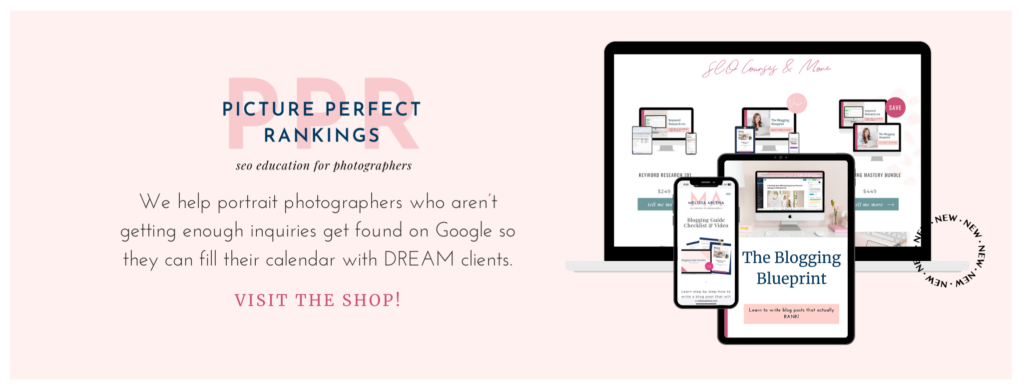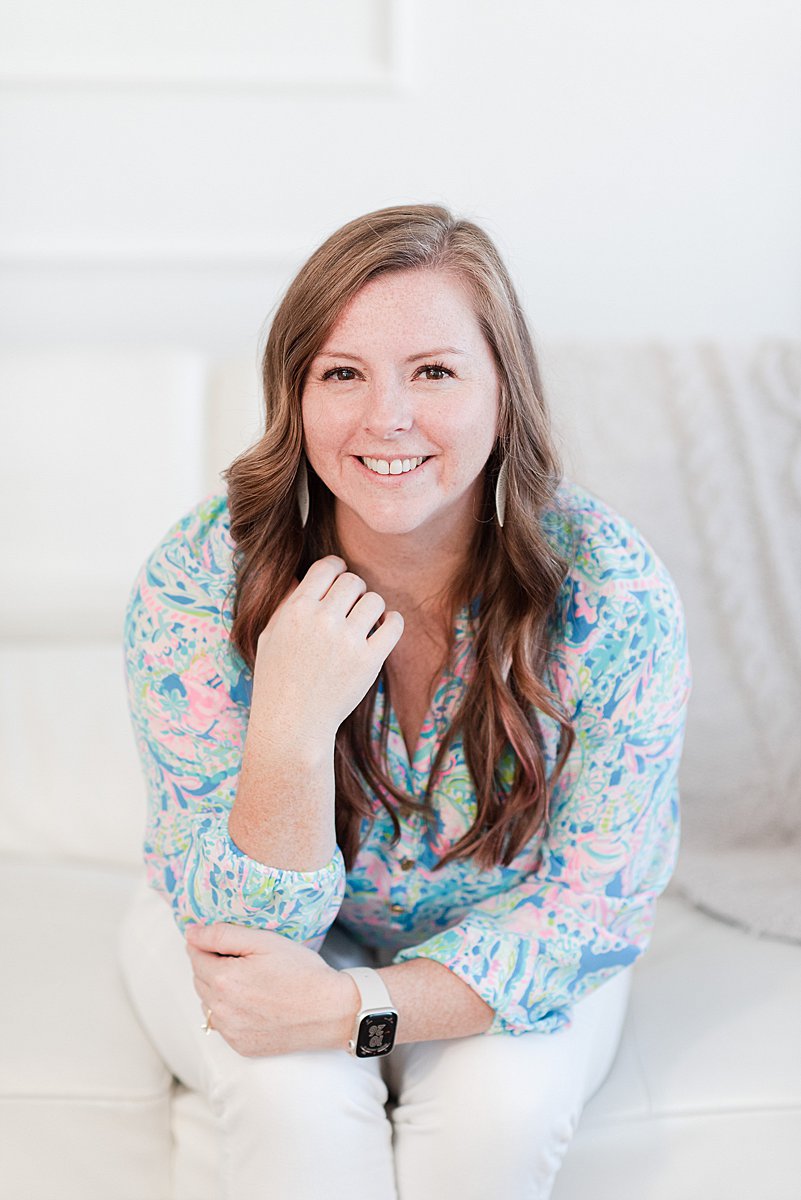SIGN Me up
lets drive traffic to your website and help grow your business
Learn How to Pick the Perfect Keyword
free download
VIEW OUR SERVICES
DIY Courses, Group Coaching, Done For You - We've got something for everyone!
SEO Services
type below and hit enter
Search the blog
Latest Biz News
SEO Tips & Tricks
Fav SEO Tools
Browse by topic
I'm Melissa Arlena(my friends call me Mel) and I help photographers get found on Google.
Read more about me
I'm so glad you're here
Blogging to Increase Your SEO : A Photographers Guide
March 21, 2024

PODCAST: This Can’t Be That Hard – EP188
I was recently a guest on Annemie Tonken’s podcast “This Can’t Be that Hard” which explores smart business strategies and systems with the goal of helping photographers at every level run profitable and sustainable businesses; So naturally, it is one of my favorite go-to podcasts!
In this episode we tackled the power of blogging! I know, it might not be at the top of your to-do list, but take a peek at our conversation below and bookmark these ideas for when you have some time on your hand! Plus if you need more help with blogging check out our course The Blogging Blueprint!
Table of Contents
The Evolution of Blogging
Annemie: Years ago I used to blog about the families I would photograph and where we went for their session, but it seems like blogging has changed since then; Is blogging still necessary and relevant?
Back then, we used to blog about our families and where they had their session, hoping for social shares on Facebook rather than focusing on SEO. I started blogging in 2012, but it was more personal, I even had a weekly post sharing my likes and dislikes (I’m saving these for my kids to read one day, but they had no SEO value). Over time, blogging has evolved, and now it’s not about documenting personal experiences but providing valuable information for clients.
The question arises: Is blogging dead? Not at all – it is still incredibly important, but the approach has changed. It’s now about addressing FAQs, offering fashion advice, and answering client questions. Blogging is crucial for increasing website traffic and improving SEO rankings. By keeping people on your site and sharing posts across platforms, you signal expertise to Google, boosting rankings. Even if the content feels less personal, it attracts visitors and helps you target keywords for better SEO. As a photographer, strategic blogging remains essential for business growth.
Pinterest Research
Annemie: Let’s delve into the practical aspects of discovering such information. When I log into Pinterest and want to know what people are currently searching for regarding photography in my area, do you have any quick tips on the most effective research methods?
You can check what’s trending on Pinterest to find popular topics. Consider seasonal trends like fall decor or Christmas presents, and plan blog posts accordingly. For instance, during Christmas, a post about photography-related gift ideas can attract attention. Planning ahead for topics such as cherry blossoms in spring or ideal vacation spots in summer allows you to create niche content. Highlighting your area’s unique features, like local beaches, can showcase your expertise and attract potential clients. Always think ahead and align your blog posts with what people are currently searching for.
Addressing Client Needs
Annemie: Do you agree that when people plan to travel, they might not specifically search for a family photographer but rather look for kid-friendly activities or general information about the area? For instance, in coastal North Carolina, where I reside, could you repurpose content to cover enjoyable family-friendly activities and highlight specific beach destinations within a blog post?
Absolutely, that’s spot on. Utilizing Pinterest for inspiration on what to wear and location ideas is great. Expanding beyond that, I find value in addressing FAQs through blog posts. When a client asks about the duration of a session, for example, turning that into a blog post with targeted keywords enhances the content. Moreover, showcasing the studio, especially if it aligns with popular keywords like “studio photography” in a particular city, is effective. A studio tour and featuring products provide engaging content for clients compared to traditional family stories.
It’s a strategic approach to keep the blog interesting and informative for our audience. As much as we love sharing our wonderful clients’ stories, most of the people visiting our website are looking for answers to questions.
Continuing on, you can think creatively about engaging content, such as highlighting local boutiques, where to shop for maternity clothes, or sharing a list of date night ideas. This expands the scope beyond photography and includes ideas for various audiences, from engagement couples to parents.
Keyword research, using tools like Keywords Everywhere, guides my content creation by identifying what people are searching for. For instance, I noticed searches for midwives, doulas, and birthing centers, prompting me to write articles targeting these topics. The strategy extends to reaching out to these professionals, letting them know they’re featured in my content, fostering connections and sometimes leading to collaboration. It’s a dynamic way to provide valuable information to clients while building relationships with local businesses.
Keyword Strategy
Annemie: In our discussion about keywords, could you elaborate on something that often confuses me— the distinction between a single word like “maternity” and a more specific phrase like “maternity photographers in South Miami”? When conducting keyword research, should I focus on individual words, entire phrases, or a combination of both?
Keyword research, in this context, is more focused on phrases than individual words. When searching for something like “maternity photography,” Google often considers the user’s location, but for smaller businesses, targeting specific phrases is more effective due to localized and less competitive results. A recommended approach is to begin with your city, genre, and either “photographer” or “photography.”
For instance, using “Miami newborn photographer” for the homepage. Understanding how people search is crucial; considering phrases like “near me” is popular, but it’s essential to incorporate specific locations for better results. The key is to think in terms of phrases as they are more likely to bring in relevant traffic. Observing how people conduct searches for local businesses and gathering feedback on their search habits can guide your keyword strategy effectively.
Annemie: Another question I have is, for someone starting with an empty blog, should they jot down every keyword even remotely related to their offerings and create individual blog posts for each, or is it more effective to select two or three keyword phrases and approach them comprehensively, creating a series of blog posts that cover various aspects of those specific keywords?
Certainly, the strategy is to have one keyword per page or blog post, treating each as a little soldier with a specific assignment to bring in traffic for that particular keyword. The goal is to avoid multiple soldiers targeting the same keyword and instead, allocate distinct keywords to different pages or posts. When doing keyword research, identify the top five or six keywords and assign them to pages on your website. The homepage should reflect your primary focus, showcasing what you love to shoot.
For instance, if weddings aren’t your preference, avoid making the homepage solely about weddings. Create a dedicated wedding portfolio page with its own keyword. When it comes to blog posts, I recommend targeting smaller locations, leaving major locations for the pages on your website. This approach ensures that each soldier, representing a specific keyword, is efficiently bringing in traffic, whether it’s a main page or a blog post focused on a smaller location.
Creating Helpful Content Blog Posts
Annemie: When it comes to deciding what to blog about, especially in the context of locations, is the focus solely on answering questions, or is there a balance between providing information and showcasing your personality? How crucial is it to incorporate personal elements into your blog content versus simply offering straightforward answers?
Certainly, when addressing FAQs or providing information, it’s natural to infuse your personal touch, showcasing how you run your business. While you can write posts that don’t specifically target SEO, it’s crucial to maintain a balance. Writing solely non-SEO posts might not have as much impact. However, it’s entirely possible to create content with a more personal touch, sharing aspects of your life or connecting with clients, even if it doesn’t directly align with SEO goals. The key is finding the right mix that allows clients to get to know you while still optimizing for search engines when needed.
Annemie: Now, let’s delve into the anatomy of a blog post. After crafting the content, are there specific calls to action that should be included in blog posts? How do you typically conclude a blog post effectively?
Absolutely, including a call to action is crucial. I recommend linking to various sections of your website, like the portfolio or products page, to keep visitors engaged on your site. By linking to related blog posts or sessions at the end, you encourage them to explore more of your content. The longer visitors stay on your site, the better it signals to Google that your content is valuable, enhancing your website’s credibility.
Blog Post Length
Annemie: What guidelines or recommendations do you have regarding the length of a blog post and the essential elements that one should ensure are included when crafting a blog post?
The landscape has shifted and while a bare minimum of 300 words used to be acceptable, that is no longer the case. Ideally, for larger keywords seeking substantial traffic, you should be aiming for around 2000 words – with the current minimum being around 500-600 words. But the key is not just hitting a specific word count; it’s about providing valuable content.
For instance, a blog post on what to wear for Fall family sessions, if well-crafted, can easily exceed 2000 words by breaking down suggestions for mom, dad, kids, and babies. The rule is the longer, the better, as long as every word contributes value for your audience. Avoid adding unnecessary words for the sake of word count; focus on delivering meaningful content.
Outsourcing Blogging
Annemie: This raises a question that many may be pondering: If someone dislikes writing or finds it time-consuming, is it possible to outsource or partially delegate this task?
Yes! Outsourcing or delegating the task of blogging is a great option. (We recommend Rokee & Co to outsource your blogging) Even if you’re not a fan of writing, you can use voice-to-text tools to get your thoughts out, and then have someone turn your spoken words into written content for a blog post. The key is consistency; you don’t need to blog every day, but maintaining a regular schedule, such as once a month or once a week, signals to Google that your website is active and regularly updated.
For those who strongly dislike blogging, a monthly schedule is a reasonable goal, but if you’re open to more, blogging once a week can significantly impact your search engine rankings. For those seeking to more quickly boost their rankings, consider outsourcing help, whether it’s for smaller, more frequent posts or by finding ways to collaborate with others.
Once you become accustomed to the blogging process, or if you just enjoy writing, the task becomes less daunting. In my experience, when I had someone blogging for me, I would review their work, making adjustments, adding personal stories, or incorporating details that might have been overlooked. This approach allows you to maintain your unique voice while benefiting from assistance in handling the initial heavy lifting of content creation.
Promoting Blog Posts
Annemie: Should your blog be highlighted front-and-center on your website? Or is it ok for it to live more in the background?
I recommend linking your blog to your homepage and displaying a couple of recent posts at the bottom. This creates a beneficial cycle where your homepage signals freshness to Google, prompting quicker crawling of your blog posts. Integrating some tips and tricks posts alongside client sessions is effective since client features might not draw as much traffic. This way, you can showcase locations and provide valuable content to your audience such as interesting anecdotes from sessions and addressing common FAQs in an engaging way.
Annemie: Once you’ve finished your latest blog posts and hit publish, what’s next? That’s not the end of the road, is it?
It is not! Once you’ve published your blog post, the goal is to maximize its reach across multiple platforms. Share it on Facebook, both on your business page and personal profile. Utilize Google My Business by posting updates with the blog title and meta description. Pin the blog post on Pinterest and share it on your boards. Incorporate it into your email newsletter. Utilize Instagram, TikTok, and Twitter for different types of posts. Share on LinkedIn and consider joining a blog circle to exchange links and comments with other bloggers. This way, your single blog post gets widespread exposure and drives traffic from various sources.
Annemie: The approach described above involves leveraging a single blog post across various platforms to maximize visibility and drive traffic. This comprehensive strategy, as outlined, acts as a business plan for executing effective SEO. It begins with the blog post and extends to social media, Google My Business, Pinterest, email newsletters, Instagram, TikTok, Twitter, LinkedIn, and even blog circles for collaboration.
The emphasis is on turning a blog post into evergreen content that continues to attract inquiries and potential clients over an extended period. The long-term value of SEO, illustrated by the continued traffic from blog posts even a decade old, demonstrates the enduring impact of this approach. It’s a meaningful and productive activity for photographers looking to boost their online presence and attract more clients. Your success story of rebuilding a business in a new state within a year, largely driven by SEO, serves as a testament to the effectiveness of this strategy.
Absolutely! So, when you’re doing things like pinning on Pinterest, you might wonder, “Will this actually get me a client?” Maybe not directly from Pinterest, but here’s the magic: it gets you traffic. The more people visit your website and spend time there, Google notices and thinks, “Hey, this person knows their stuff!” So when someone searches for keywords related to your homepage, Google’s like, “I’ve got the perfect recommendation!” It’s like your website gains authority points, and that helps boost your ranking. So, those seemingly small actions, like sharing your blog post all over, add up to make a big impact on your business!

Melissa & Alison have taken their polo’s public in their new podcast Keep It Moving. With a combined 27 years of experience in photography and nine business relocations under their belts, they share their insights and actionable steps to help you navigate the challenging process of moving your business.
From SEO and Instagram tips to location scouting, pre-move checklists, networking and more they will cover it all. They are mapping out exactly how they have moved their businesses and started booking clients in their new locations even before they have packed any boxes. Moving your business is hard and these girls can show you how to do it successfully!

I’m Melissa Arlena, founder of Picture Perfect Rankings, where we help portrait photographers get found on Google and transform from invisible experts into market leaders. With 15+ years of photography experience and an IT background, I’ve helped hundreds of photographers break free from feast-or-famine cycles by achieving page 1 rankings that attract their dream clients through search.
I'm Melissa Arlena(my friends call me Mel) and I help photographers get found on Google.
Read more about me
I'm so glad you're here
Hello!
join the blogging club
login to courses
shop
services
SEO for photographers doesn't have to be complicated. Join our VIP Facebook group today!
Picture Perfect Rankings
join our vIP facebook group
© 2023-2025 Picture Perfect Rankings : SEO for photographers. all rights reserved. privacy policy.